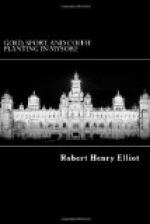I have pointed out that the five trees I have recommended as being the best for shade can all be grown from cuttings, and it is important to point out that these should be taken from young and vigorous trees, and not, as is often done, from trees which are declining from age. There are some useful remarks at pages 88 and 89 of Mr. Graham Anderson’s “Jottings on Coffee,” on the preparation and planting of cuttings. The holes should be two feet deep, and filled up to three-quarters of the depth with soil. The cuttings should be six feet long with a fork at the top. They should be made at the beginning of the monsoon, and left in a cool and shady place in order to thicken the sap, the lower extremity of the cutting should be cut off with a curved slope, like the mouth-piece of a flageolet. Put the cutting gently into the hole, so as not to fray the bark, and tread down firmly. Wounds should be smeared with a mixture of cowdung and mud. The atti (Ficus glomerata) may also be grown from cuttings, but these should be rather thinner than those taken from the five trees first mentioned as being the best to plant for shade.
It has been previously pointed out that charcoal trees are valuable as nurses. They may be raised by clearing and burning a small piece of jungle, or by putting some virgin jungle soil in a bed and watering it, when charcoal plants will spring up. When a few inches high, take the plants up carefully with a ball of earth and transplant into baskets filled with jungle top soil. Put out the plants with their baskets in holes about the size of those usually made for coffee plants, and early in the monsoon, and see that they are well protected from cattle.
In conclusion, I think it well to mention that we have on my property, so far as I am aware, by far the oldest artificial shading of coffee in India. For many years all the estates in Mysore relied on the original forest shade, but mine was partly destroyed by a running fire when the clearings were first made, and some of the land was cleared wholly down, burned off, and planted with the most desirable kinds of shade trees. Our experience on this property dates back to the year 1857, and is therefore particularly valuable, for the defects connected with some trees were not apparent for as much, in one important case, as thirty years.
FOOTNOTES:
[52] I regret that I am unable to give the botanical name of this tree, and of some others subsequently mentioned. I have drawn up a list of trees, some of which may be retained till better trees can be grown to supply their places, and also of other trees which are positively injurious to coffee, but do not publish them, partly in order to save space, and partly because I have not been able to ascertain the botanical names of all the trees in question.
[53] My manager last year weighed and counted the Jack fruits from a single tree. There were forty fruits which weighed 572 lbs. The largest fruit weighed 30 lbs.




